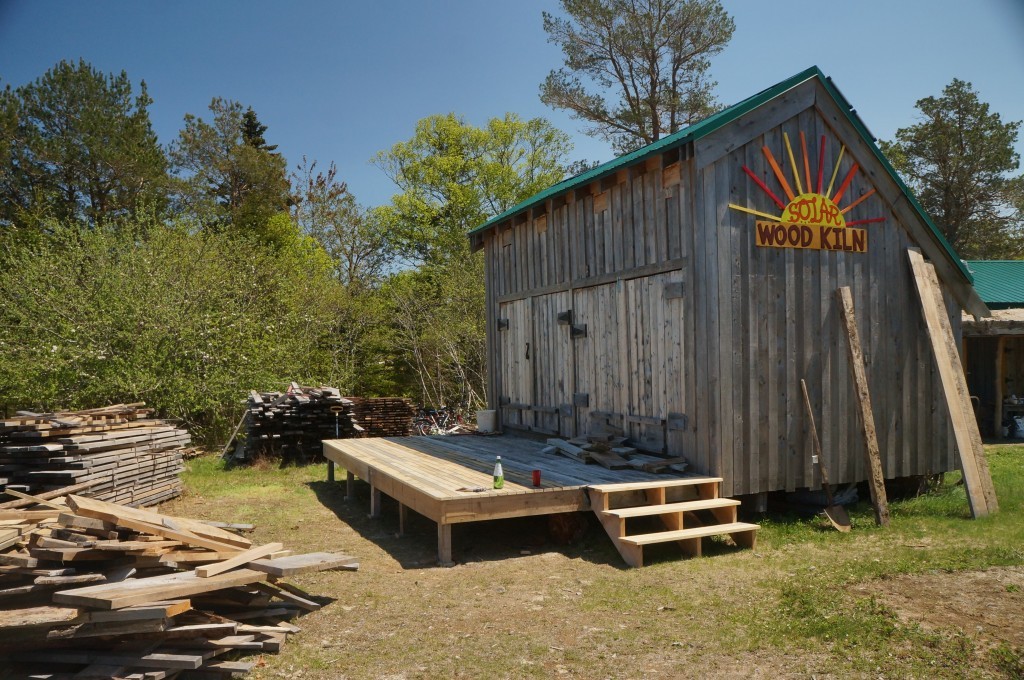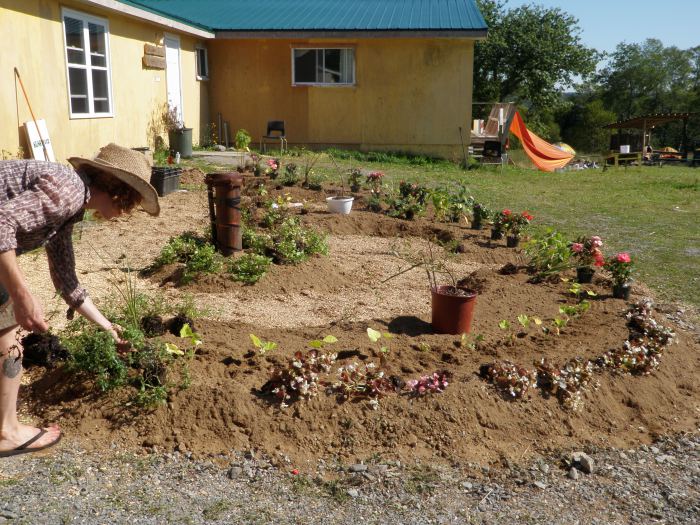Construction of a solar wood kiln at the Deanery Project began in 2011 in response to a donation of felled city trees, and to further the Deanery’s interests in sustainable woodland management. In addition to creating resources for value added wood products, the solar wood kiln is an important teaching tool.
PROJECT HISTORY
In 2011 forty-seven trees were cut at Dalhousie University to make way for the new Ocean Sciences Building. Rather than sending them to landfill, as is the typical practice for urban tree disposal, the trees were donated to the Deanery Project in hopes that an environmentally responsible use for the trees could be found.
A grant from TD Friends of the Environment, in partnership with Dalhousie University, and support from many volunteers enabled the Solar Kiln to be built the same year. In addition to providing value added wood products, the solar wood kiln helps:
 illustrate basic passive solar design and solar heating principals
illustrate basic passive solar design and solar heating principals- motivate local woodlot owners to consider low-impact, value-added opportunities for their wood.
- create educational experiences to build skills connecting natural building and the forest industry
The trees received from Dalhousie were milled on site by local sawyer Robert Conrad, and dried over the winter in the solar kiln. The following summer the wood was used to build benches for the main Atrium of the building that had been constructed on the site where the trees were originally harvested – a lasting example of how value added opportunities can be found when trees have had to be cut.
The Solar Wood Kiln has become a unique, functional structure at the Deanery Project, providing a window into environmentally responsible ways of working with wood. It is the hope of The Deanery Project that many more such kilns will be built in communities across Nova Scotia.
Design and construction of the kiln was made possible by a grant from TD Friends of the Environment and a generous donation of aqua-salvaged lumber from John Dicks. Other project partners included Clean Nova Scotia and ADTS who transported the wood to the Deanery, and the many community members who contributed labour and materials to complete the project.
DESIGN FEATURES
The kiln is has an indoor floor area of 180 square feet and can hold a maximum load of 2000 board feet of lumber. Many interesting and sustainable design features have been integrated into the building design, including:
- Recycled metal roofing
- Recycled tempered solar glazing
- Recycled tires filled with rammed earth for the foundation
- Solar D.C. fan operation without batteries
- Advance framing techniques designed for minimal material use
- Dense packed cellulose insulation
- Reclaimed lumber for frame salvaged from the bottom of a local lake
- Multi functional design can dry wood, food, herbs, craft materials
- Heat could contribute to heating needs of auxiliary building
- Modular design means it can be mounted on a trailer and moved to woodlots for itinerant or long term use where wood is being harvested
It should be noted that the Deanery’s solar kiln is a “large batch kiln” and is a pilot project for Nova Scotia; Simpler, more affordable versions can be built on a smaller scale to serve a variety of purposes.
HOW IT WORKS
The kiln is positioned with its roof facing south to ensure maximum exposure to the sun throughout the day. Energy from the sun enters the heat box through glazing on the roof of the kiln, and is contained by dark metal heat collector plates. The warmed air is then circulated through “stickered” lumber by four (recycled) 12 volt fans powered by two small solar photovoltaic panels. When there is enough sun to raise the temperature in the kiln, there is also enough sun to run the fans. They circulate the air, maintaining good ventilation and relative humidity within the kiln. A tarp hung in the kiln forms a baffle which forces the air to flow through the lumber instead of around it. Ventilation is provided by manually opening and closing vents that are strategically placed along the front and rear of the structure. The lower vents allow moist air to escape, while vents toward the ceiling allow fresh air to be circulated; these vents can be opened or closed depending on humidity levels and how long the wood has been in the kiln. At night, the fans stop running and the moisture within the kiln condenses back onto the wood. This conditions the wood, easing drying stresses built up during the day and resulting in a high quality product.
ENVIRONMENTAL BENEFITS
Typically one of the biggest energy and economic costs in timber manufacturing is drying of the wood. In order to improve quality, yield, value outcomes and reduce environmental impact, solar kilns are recognized as an excellent drying technology solution where the focus is on a superior end product and energy efficiency. Energy costs typically account for 30% to 60% of the total drying process and cost and up to 60% of the energy required to convert logs to dry sawn timber. Solar kilns don’t use boilers and wood-waste burners to provide heat, so there are fewer pollutants, environmental hazards and environmental compliance costs associated with burning wood.








